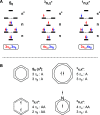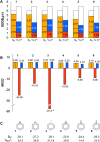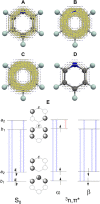The n,π* States of Heteroaromatics: When are They the Lowest Excited States and in What Way Can They Be Aromatic or Antiaromatic?
- PMID: 38787346
- PMCID: PMC11163469
- DOI: 10.1021/acs.jpca.4c02580
The n,π* States of Heteroaromatics: When are They the Lowest Excited States and in What Way Can They Be Aromatic or Antiaromatic?
Abstract
Heteroaromatic molecules are found in areas ranging from biochemistry to photovoltaics. We analyze the n,π* excited states of 6π-electron heteroaromatics with in-plane lone pairs (nσ, herein n) and use qualitative theory and quantum chemical computations, starting at Mandado's 2n + 1 rule for aromaticity of separate spins. After excitation of an electron from n to π*, a (4n + 2)π-electron species has 2n + 2 πα-electrons and 2n + 1 πβ-electrons (or vice versa) and becomes πα-antiaromatic and πβ-aromatic. Yet, the antiaromatic πα- and aromatic πβ-components seldom cancel, leading to residuals with aromatic or antiaromatic character. We explore vertically excited triplet n,π* states (3n,π*), which are most readily analyzed, but also singlet n,π* states (1n,π*), and explain which compounds have n,π* states with aromatic residuals as their lowest excited states (e.g., pyrazine and the phenyl anion). If the πβ-electron population becomes more (less) uniformly distributed upon excitation, the system will have an (anti)aromatic residual. Among isomers, the one that has the most aromatic residual in 3n,π* is often of the lowest energy in this state. Five-membered ring heteroaromatics with one or two N, O, and/or S atoms never have n,π* states as their first excited states (T1 and S1), while this is nearly always the case for six-membered ring heteroaromatics with electropositive heteroatoms and/or highly symmetric (D2h) diheteroaromatics. For the complete compound set, there is a modest correlation between the (anti)aromatic character of the n,π* state and the energy gap between the lowest n,π* and π,π* states (R2 = 0.42), while it is stronger for monosubstituted pyrazines (R2 = 0.84).
Conflict of interest statement
The authors declare no competing financial interest.
Figures










Similar articles
-
Toward a Systematics for the Lowest Excited States of Heteroaromatics Enabled via Cyclic π-Conjugated Carbenes and Heteroelement Analogues.J Org Chem. 2025 Jul 18;90(28):9743-9756. doi: 10.1021/acs.joc.5c00578. Epub 2025 Jul 8. J Org Chem. 2025. PMID: 40626793 Free PMC article.
-
Global Aromaticity in Macrocyclic Polyradicaloids: Hückel's Rule or Baird's Rule?Acc Chem Res. 2019 Aug 20;52(8):2309-2321. doi: 10.1021/acs.accounts.9b00257. Epub 2019 Jul 17. Acc Chem Res. 2019. PMID: 31314487
-
Cyclopropyl Group: An Excited-State Aromaticity Indicator?Chemistry. 2017 Oct 4;23(55):13684-13695. doi: 10.1002/chem.201701404. Epub 2017 Sep 1. Chemistry. 2017. PMID: 28683165
-
Porphyrinoids, a unique platform for exploring excited-state aromaticity.Chem Soc Rev. 2022 Jan 4;51(1):268-292. doi: 10.1039/d1cs00742d. Chem Soc Rev. 2022. PMID: 34879124 Review.
-
Quinodimethanes Incorporated in Non-Benzenoid Aromatic or Antiaromatic Frameworks.Top Curr Chem (Cham). 2018 Mar 20;376(2):12. doi: 10.1007/s41061-018-0189-0. Top Curr Chem (Cham). 2018. PMID: 29557513 Review.
Cited by
-
Magnetic Antiaromaticity─Paratropicity─Does Not Necessarily Imply Instability.J Org Chem. 2023 Oct 20;88(20):14831-14835. doi: 10.1021/acs.joc.3c01807. Epub 2023 Sep 29. J Org Chem. 2023. PMID: 37774173 Free PMC article.
-
Strong Ferromagnetic Coupling between Co and Co2+ with Odd Electron (Anti)aromatic Radicals via Noncovalent Interaction.J Phys Chem A. 2025 May 22;129(20):4426-4437. doi: 10.1021/acs.jpca.5c01107. Epub 2025 May 9. J Phys Chem A. 2025. PMID: 40346467 Free PMC article.
-
Toward a Systematics for the Lowest Excited States of Heteroaromatics Enabled via Cyclic π-Conjugated Carbenes and Heteroelement Analogues.J Org Chem. 2025 Jul 18;90(28):9743-9756. doi: 10.1021/acs.joc.5c00578. Epub 2025 Jul 8. J Org Chem. 2025. PMID: 40626793 Free PMC article.
-
Antiaromaticity in molecular assemblies and materials.Chem Sci. 2024 Oct 24;15(45):18677-97. doi: 10.1039/d4sc05318d. Online ahead of print. Chem Sci. 2024. PMID: 39512924 Free PMC article. Review.
-
Aromaticity and Antiaromaticity Reversals between the Electronic Ground State and the Two Lowest Triplet States of Thiophene.Chemphyschem. 2025 Jan 2;26(1):e202400758. doi: 10.1002/cphc.202400758. Epub 2024 Nov 5. Chemphyschem. 2025. PMID: 39305154 Free PMC article.
References
-
- Luo D.; Jang W.; Babu D. D.; Kim M. S.; Wang D. H.; Kyaw A. K. K. Recent Progress in Organic Solar Cells Based on Non-Fullerene Acceptors: Materials to Devices. J. Mater. Chem. A 2022, 10, 3255–3295. 10.1039/D1TA10707K. - DOI
-
- Chen X.; Tan D.; Yang D.-T. Multiple-Boron–Nitrogen (multi-BN) Doped π-Conjugated Systems for Optoelectronics. J. Mater. Chem. C 2022, 10, 13499–13532. 10.1039/D2TC01106A. - DOI
LinkOut - more resources
Full Text Sources
Research Materials
Miscellaneous

